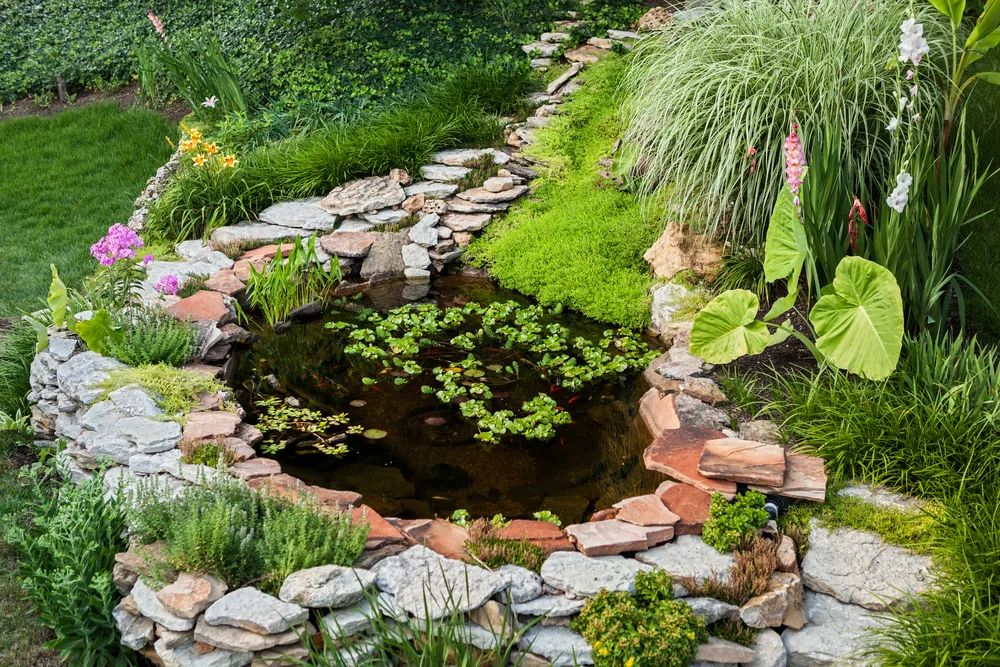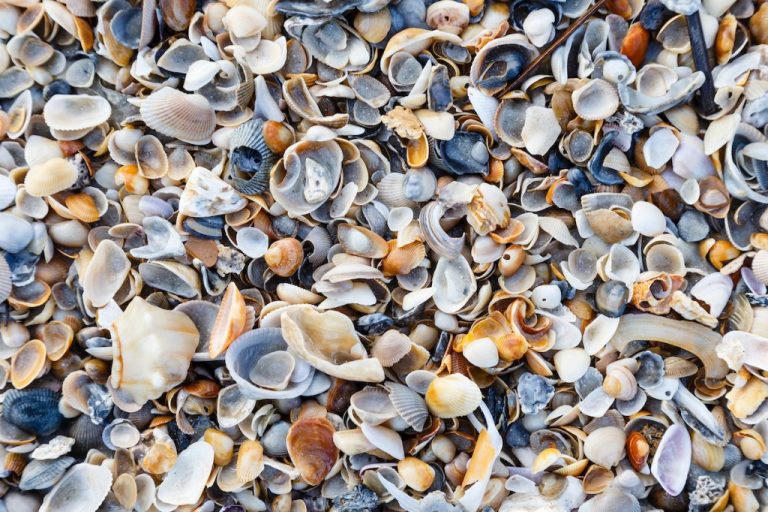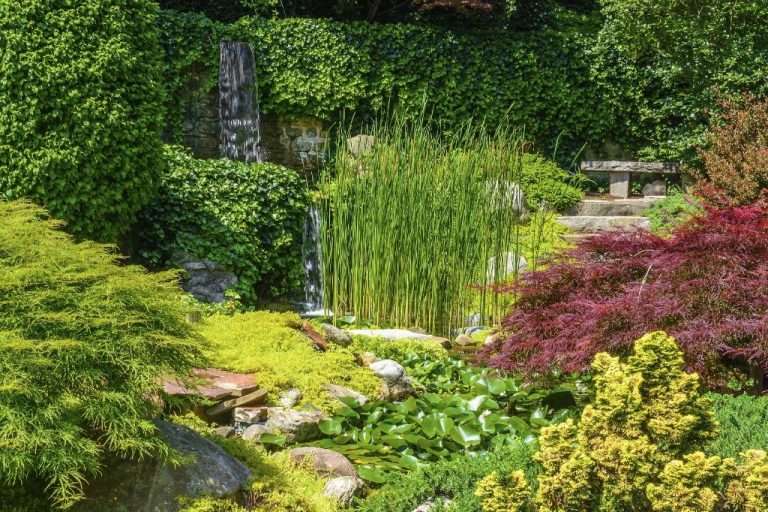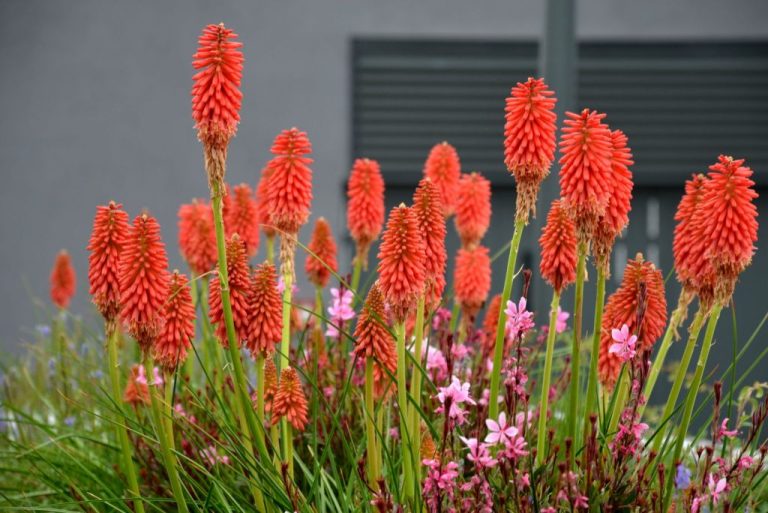Incorporating Water Features Into Your Garden Design
Water features like fountains, ponds, and waterfalls can add beauty and serenity to any garden design. The soothing sounds of moving water create a relaxing ambiance, while the shimmering surfaces attract birds, butterflies, and other desirable wildlife. Water features also help regulate temperature and humidity in the garden. According to Forbes (https://www.forbes.com/sites/jamiegold/2023/05/02/water-features-add-architectural-flair-wellness-benefits-and-real-estate-enhancements-to-a-home/), water features can even boost property values. This article provides an overview of the various types of water features and considerations for incorporating them into your garden design.
Types of Water Features
There are several common types of water features that can be incorporated into garden designs.
Ponds are one of the most popular water features. They can be designed in a formal geometric shape or a more natural, freeform style. Ponds create a serene environment and provide habitat for fish, frogs, and other wildlife. Koi ponds are especially prized for the brilliant colors and graceful movements of koi fish. According to this guide, ponds should be at least 2 feet deep to help prevent algae growth.
Fountains add visual interest and the soothing sounds of moving water. They can be designed in a wide variety of shapes and styles, ranging from classic stone or bronze fountains to more modern designs. Fountains work well in both formal and informal garden settings. There are self-contained fountains as well as those that require plumbing to connect to a water source, as outlined in this overview of water feature types.
Waterfalls and cascades lend drama as water flows down textured rocks or walls. The white noise of the moving water helps block out unwanted background sounds. Cascades can be designed to recirculate water or have water gently streaming over the edge. Plants such as ferns planted around waterfalls can complement the natural effect.
Stream features guide the flow of water through the landscape. The water can run over rocks, pebbles or gravel, creating an aesthetic reminiscent of a natural stream. Streams are often designed as part of pondless water features, with the water recirculating from a hidden reservoir.
Considerations for Placement
When deciding where to position a water feature in your garden, there are a few key factors to consider:
Sun exposure – Most aquatic plants thrive in partial sunlight, so aim for 4-6 hours of sun exposure daily. Too much sun will cause algae growth, while too little sun prevents healthy plant growth. Consider sun patterns when choosing a site.
Proximity to seating areas – Locate your water feature where you can enjoy the sights and sounds from a patio, deck or bench. Meandering paths leading to the water feature allow you to fully appreciate it. Position it near outdoor living spaces for maximum enjoyment.
Views – Carefully consider sight lines from inside your home and key outdoor areas. Choose a prominent site with good visibility from multiple vantage points. Frame desirable views, and block any unsightly areas with strategic placement.
According to BHG’s guide on backyard water features (https://www.bhg.com/gardening/landscaping-projects/garden-structures/backyard-water-feature-ideas/), incorporating a water feature next to a pathway or steps allows you to admire it frequently.
Maintenance Requirements
Proper maintenance is crucial for keeping your water feature looking pristine and operating smoothly. Here are some key maintenance tasks you’ll need to perform:
Cleaning
It’s important to regularly clean your water feature to prevent buildup and keep the water clear. Aim to clean the water feature every 1-3 months. First, drain the water into the surrounding landscape using a submersible pump. Then use a soft cloth or brush with a garden hose to gently remove any dirt, debris, and algae buildup on the rocks, gravel, and other surfaces, working from top to bottom. You can use a mild non-toxic cleaner like white vinegar to help remove stubborn stains. Rinse thoroughly before refilling the fountain.

Algae Control
Algae can quickly take over and turn your lovely water feature into a green mess. Prevent algae growth by using an algaecide product and changing the water frequently. There are several algaecide options safe for fish and plants, like hydrogen peroxide, sodium percarbonate, and polyquad-based products. Follow dosage instructions carefully.[1]
Winter Preparations
In colder climates, you’ll need to properly winterize your water feature to prevent weather damage. Drain all the water and disconnect hoses and tubing. Remove the pump and clean it thoroughly before storing it for the winter. Use pump lubricant to prevent the impeller from sticking. Cover surface with an insulating waterproof tarp. Consider placing a pond de-icer to keep a small area ice-free and prevent damage.
Safety Precautions
When installing a water feature in your garden, it is important to take proper safety precautions to prevent accidents and injuries. Some key considerations include:
Prevent access for small children and pets by installing fencing or barriers around the water feature. According to experts, “Pondless water features: Consider water features that don’t have standing water at the base to prevent accidental drowning of pets and small children. Fencing can help restrict access as well” (https://wplawinc.com/residential-water-features-safety-tips-to-keep-your-family-safe).
Make sure any underwater lighting or pumps are properly secured and inaccessible. Consider using solar powered pumps and lights when possible to reduce risk of electrocution.
Install non-slip surfaces around the water feature to prevent falls and injuries. Proper drainage is also key to avoid excess water collecting.
Place warning signs indicating depth of water and risk of drowning. Supervise children when they are around the water feature.
Water features can be designed safely by addressing these concerns. But proper precautions are needed, especially in homes with small children and pets.
Choosing the Right Plants
When selecting plants for your water feature garden, it’s important to choose moisture-loving species that will thrive in the humid microclimate created by the water. Some excellent options include Japanese iris, canna lilies, elephant ears, swamp milkweed, creeping Jenny, and nasturtiums (Newprocontainers.com, 2023).
Opt for plants suited to your specific hardiness zone and sunlight conditions. Be sure to avoid invasive species that could spread uncontrollably. Species like yellow flag iris and purple loosestrife are banned in some regions because they choke out native plants.
Instead, stick to non-invasive choices that will remain contained. The moisture-rich soil around ponds and fountains provides ideal growing conditions for many perennials, annuals, shrubs and trees. Just be sure they are adapted to the sunlight levels in that area of your yard.
Some great options for full sun areas include canna lilies, hibiscus, Japanese iris, swamp milkweed and cardinal flowers. For shade, consider astilbe, turtlehead, creeping Jenny, Japanese primrose and swamp lilies (Better Homes & Gardens, 2023). With the right plant selections, you can create a thriving underwater garden.
Incorporating Lighting
Adding lights to a water feature can enhance its beauty and visual interest. There are several types of lighting to consider:
Underwater Lights: Submersible LED lights can illuminate the water from below, creating a glowing, ethereal effect. Opt for energy-efficient LEDs in a range of colors. Install them safely using a waterproof transformer placed away from the water’s edge.
Spotlights: Spotlights on the ground or mounted in trees can highlight specific elements like pouring water or a statutes. Use LED or halogen spotlights with interchangeable filters and beam spreads for effects. Focus the light on key areas and avoid glare.
Ambient Lighting: Path lights, step lights and uplighting from small spotlights create overall ambiance. Place path lighting to illuminate walking areas around the feature. Uplighting placed in ground can cast dramatic shadows and reflections on water surfaces and foliage. Choose warm white lighting for a cozy mood.
Mixing multiple lighting types creates depth and visual interest after dark. Consider energy efficiency, safety, and ambiance when incorporating lighting. Use effects sparingly to avoid overwhelming the senses or creating glare. Lighting allows water features to make a stunning nighttime impression.
Source: https://www.aquascapeconstruction.com/water-gardening-articles/backyard-and-garden-lighting-ideas
Adding Complementary Features
Adding small complementary features can enhance the beauty and enjoyment of your water feature design. Here are some ideas to consider:
Benches
Strategically placed benches allow you to sit and enjoy the sights and sounds of your water feature. Select a bench made of complementary materials like stone, concrete, or wood. Position it across from or beside your water feature for the best vantage point. Ensure the bench is on a flat, stable surface.
Bird Baths
A bird bath placed near your water feature provides birds with a landing spot to bathe and drink. Opt for a pedestal style made of material like concrete, metal or stone that matches your water feature. Keep it in scale with the size of your garden. Place it on level ground within view of the water feature for birds to easily move between the two.
Stepping Stones
Natural stone stepping stones winding through plantings towards your water feature help tie the whole garden together. They also create an inviting path for visitors to approach and admire your water scene up close. Select flat stones in muted colors and varied shapes to complement your garden style. Arrange them spaced apart with plants growing up in between for visual interest.
Citing sources: https://www.gardendesign.com/ideas/water-features.html
Design Inspiration
Water features can take on a wide variety of designs to fit any style of garden. Here are some photos for inspiration:
This peaceful pond has lily pads and a small waterfall cascading over rocks. The sound of moving water adds tranquility to the garden. Source: Better Homes and Gardens
A stacked stone waterfall flows gently into a round pond surrounded by flowers and plants. The curved shape fits nicely into the garden’s layout. Source: Better Homes and Gardens
This contemporary water feature consists of a sheet of water flowing down a flat stone wall into a narrow channel. The minimalist style pairs nicely with modern architecture and gardens. Source: Better Homes and Gardens
For a unique look, this garden incorporates metal buckets overflowing with water and spilling into a pool below. The recycled buckets add visual interest. Source: Better Homes and Gardens
A small stone fountain located in the corner of this courtyard garden provides a focal point. The gentle splashing adds ambience. Source: Better Homes and Gardens
Looking through these photos shows the diverse possibilities for integrating water features into garden designs, from grand ponds to simple fountains. There are options to fit any style or budget.
Conclusion
Adding a water feature to your garden design can provide many benefits, both aesthetically and functionally. In summary, water features create soothing sights and sounds that promote relaxation, reduce noise pollution, attract wildlife, and add visual interest. When thoughtfully incorporated, they can become a beautiful focal point and really elevate your landscape. Just be sure to consider placement, maintenance needs, safety, and complimentary plants and lighting when planning your water feature. With proper care and design, integrating a fountain, pond, or other water element can transform your garden into a serene, natural paradise right at home.
When incorporating water, start by identifying your goals and needs to select the right feature, whether that’s a calming fountain or lively pond. Carefully plan the placement and necessary maintenance to keep your water healthy and functioning properly. Adhere to safety guidelines, especially with children or pets. Finally, thoughtfully integrate complementary elements like plants, lighting, seating areas, and hardscaping to create a cohesive and inviting space. With creativity and intention, adding water to your garden can bring life, tranquility, and joy to your outdoor living area.





